Hydroplaning is where your wheels lose contact with the road. It’s an example of weather-related automobile accidents, which, according to The Weather Channel, kill an average of 5,376 people annually.
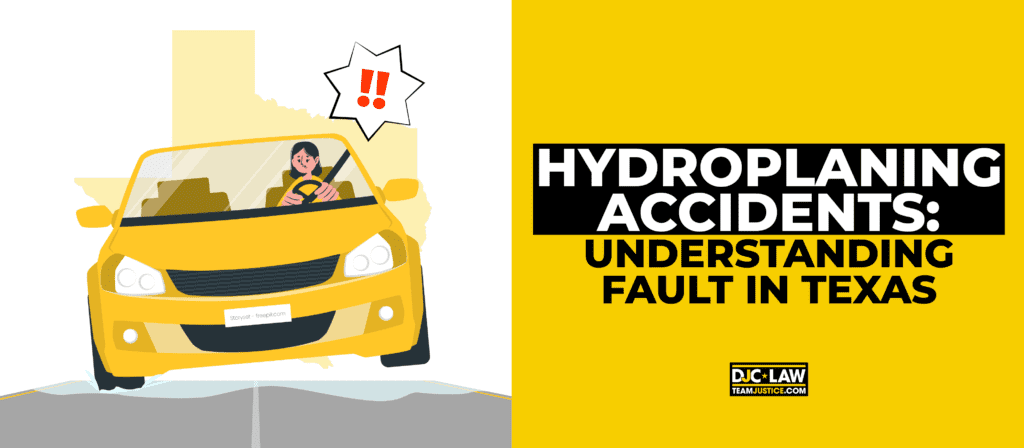
Anyone who’s ever hydroplaned knows how sudden and scary it can be. While hydroplaning, you have little to no control over your vehicle, which naturally increases the risk of catastrophic results. After all, the Department of Transportation reports that more than 544,700 people are injured due to wet roads every year.
However, determining fault isn’t always straightforward. In this guide, we discuss how hydroplaning works and how courts determine fault when it causes accidents.
Key Takeaways
Hydroplaning is when tires lose contact with a wet road surface, leading to a loss of control.
Drivers can cause hydroplaning by driving too fast or improperly maintaining their vehicles.
The biggest risks associated with hydroplaning include speeding, reckless driving, bald tires, and failing to adapt to the conditions.
Liability in hydroplaning collisions is determined by evaluating road traffic violations, vehicle maintenance, and driver actions. Under Texas’s at-fault laws, proportional responsibility is in effect.
Successful claims can yield compensation for medical bills, lost wages, pain and suffering, wrongful death, and more, depending on the extent and long-term impact of your injuries.
After a hydroplaning accident, it’s best to contact an attorney at the earliest possible opportunity to build a case and ensure that your losses are properly compensated.
What is Hydroplaning?
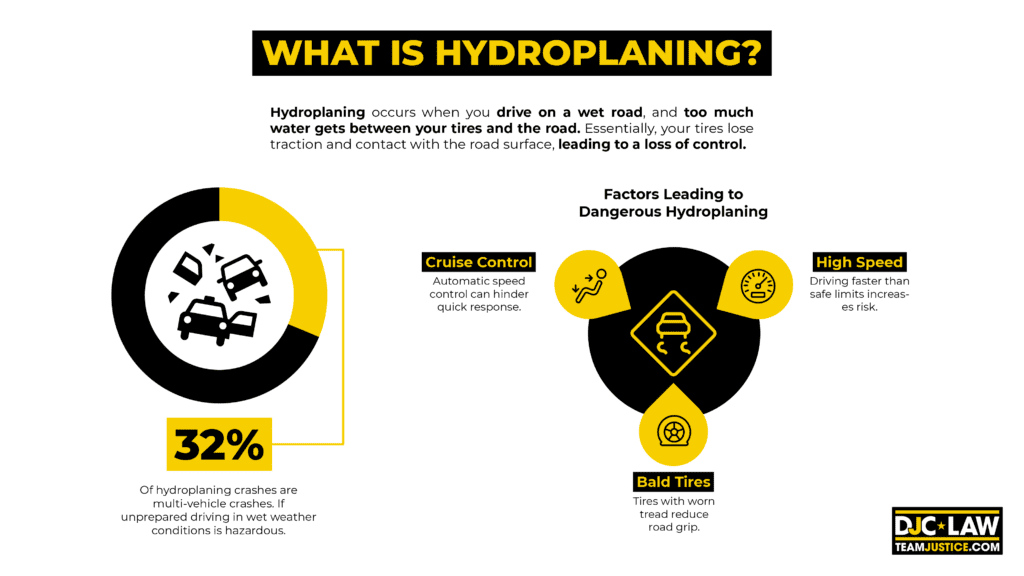
Hydroplaning occurs when you drive on a wet road, and too much water gets between your tires and the road. Essentially, your tires lose traction and contact with the road surface, leading to a loss of control. Most instances of hydroplaning are momentary, but even these short periods can lead to disaster.
Loss of control can quickly lead to serious incidents, as the data shows. According to ScienceDirect, 32% of hydroplaning crashes are multi-vehicle crashes. It’s why driving in wet weather is so hazardous, especially if you’re unprepared.
It’s also entirely possible that drivers lose steering control, power control, and brake control. Although most people get through a hydroplaning incident without any problems, loss of control is substantially more dangerous when:
Drivers are moving too quickly. High rainfall means you shouldn’t be going at the speed limit.
You’ve got bald tires that reduce how much traction with the road you have.
You’re allowing your car to proceed on cruise control.
The worst crashes occur when drivers experience a total loss of control, which can lead to an impact on another vehicle or a roadside obstacle. That’s why knowing what to do if your car starts to hydroplane is essential to avoid issues like sideswipe accidents or frontal impacts.
Note that not all roads are susceptible to hydroplaning. According to the Alabama Water Institute, only 24% of roads in the continental U.S. are prone to hydroplaning events, with the risk being significantly higher in southern states.
Do Drivers Cause Hydroplaning?
Hydroplaning isn’t a natural occurrence or guaranteed. Most hydroplaning incidents are caused by drivers who fail to adapt to the conditions. The most common reasons hydroplaning crashes occur are speeding, worn tires, and panicking when hydroplaning does occur.
Although hydroplaning may occur on any road surface when the rain starts, SafeMotorist reveals that the first ten minutes of light rain are the most dangerous. During this period, the initial downpour mixes with oil residues on the road, causing slicks that can result in hydroplaning.
Despite this, hydroplaning can happen even to the best drivers. Some of the reasons why you might hydroplane even when taking steps to avoid it include:
Improper road drainage
Poor maintenance
Sudden rain storms
Hydroplaning often happens, and you can’t do anything about it. The question is who’s at fault if an instance of hydroplaning results in an auto accident.
San Antonio Hydroplaning: Who is at Fault in a Hydroplaning Accident in Texas?
Determining fault for hydroplaning collisions follows the same initial considerations of speeding, distracted driving, reckless driving, and other traffic violations. Assuming no violations occurred, the issue moves to determine whether drivers had the appropriate tire tread of 2/32 of an inch and other vehicle maintenance issues.
Actually determining fault for a hydroplane-related sideswipe accident is more complicated because of the conditions. Sometimes, cases are won by finding out that a driver simply chose to drive in situations that had already been deemed to be unsafe.
Your personal injury attorney will examine the following factors when determining liability:
Road Conditions
The overall condition of the road can create liability because improperly maintained surfaces increase the likelihood of hydroplaning. If a road has no draining efficiency, it could create the conditions for hydroplaning.
Tire Tread and Design
Tire tread depth is your protection against hydroplaning. Old, bald tires are less able to prevent water buildup and maintain contact with the road. According to the Texas Department of Public Safety, the minimum tire tread depth is 2/32 unless the vehicle is a heavy vehicle, such as a truck or bus.
Tread alone isn’t the only consideration for determining fault. Some tire tread designs are more vulnerable to hydroplaning than others. For example, some tread designs may excel at:
Effective water displacement
Maintaining turn traction
Directional acceleration
Groove and void ratio are other metrics that influence whether your tires are suited to wet roads. Specific designs help to break up standing water and channel it away from the tires, thus maintaining contact with the road.
Speed
Your speed is one of the critical elements that will be examined in any hydroplaning auto accident case. Going too fast for the conditions is one of the leading causes of accidents in wet weather conditions.
Whenever you increase the speed of your vehicle, you decrease the time your tires have to clear the water away. That’s why driving safety experts recommend reducing your speed according to the conditions.
Just because you can drive at 70 mph down a highway doesn’t mean you should if a deluge falls on your head. Although the Texas Transportation Code 546.343 doesn’t specify a minimum speed, you should drive for the conditions without impeding traffic flow.
Vehicle Weight
Avoiding hydroplaning means displacing water at a fast enough rate to prevent your tire tread from losing contact with the road. Heavier vehicles are less likely to hydroplane because they have more weight pressing down on the tires, which helps them to displace water.
Despite this, all vehicles must drive according to the conditions. Heavier vehicles can still hydroplane like any other type of vehicle. Likewise, heavier vehicle weights require deeper treads and different groove designs. For example, the 2/32 tread rule for regular vehicles changes to a 4/32 minimum for heavier vehicles.
What is Proportionate Responsibility?
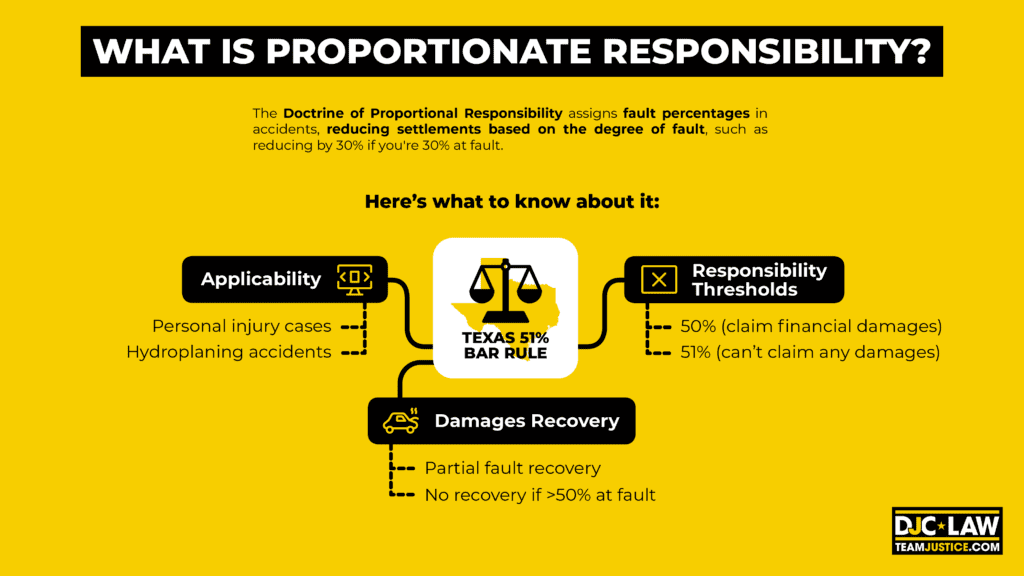
The Doctrine of Proportional Responsibility, or comparative negligence, is a legal principle determining the extent of fault each party bears in a lawsuit. Each party’s degree of fault is established, and a final settlement award is divided accordingly.
For example, if you were found to be 30% at fault for a hydroplaning accident, your final settlement would be reduced by 30% to account for the party you played in the accident.
Under Texas law, the 51% bar rule is also in effect. It means that if you’re more than 50% responsible for the injury, you can’t claim any financial damages from the other party. Here’s what to know about it.
It applies in all personal injury cases, including hydroplaning lawsuits.
It enables shared responsibility. However, even if you’re partially responsible, you can still recover damages.
The 51% bar rule has a threshold stating that if you are more than 50% responsible for an accident, you can’t claim financial compensation.
What are the Responsibilities of the Driver?
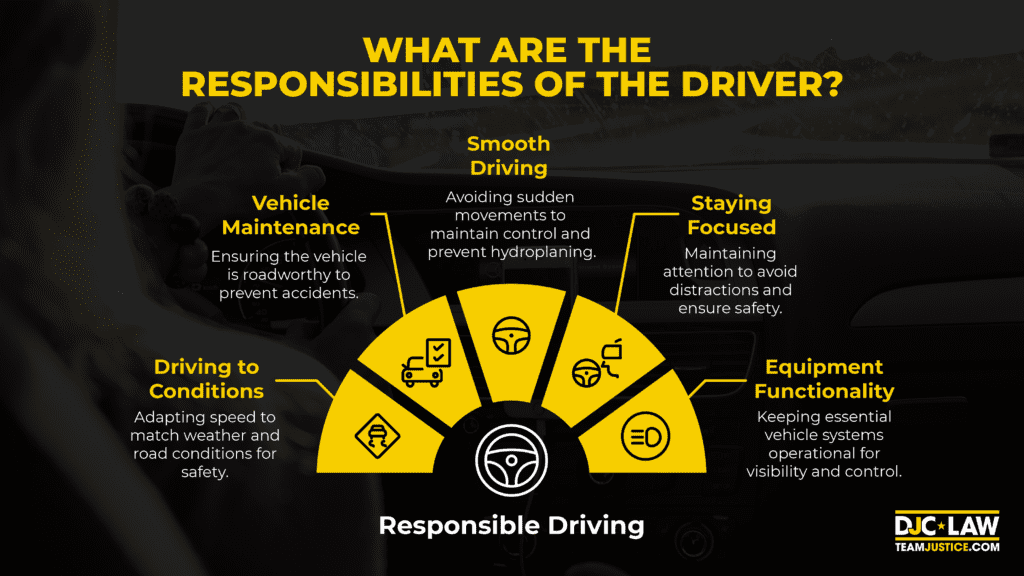
Drivers must ensure they drive to the conditions and that their vehicles have been properly maintained. Although hydroplaning can happen regardless, drivers can contribute to these accidents and are expected to mitigate the chances of a crash as much as possible.
Your responsibilities include but are not limited to:
Driving to the Conditions – You’re expected to adapt your speed to the weather and the road conditions. For example, you should slow down if there’s heavy rain or standing water on the road.
Maintain Your Vehicle – All drivers are responsible for ensuring their vehicles are roadworthy. If you have a crash and it’s found that your tires have low tread depth, you could be held responsible for an accident.
Driving Smoothly— Sudden movements are one reason hydroplaning accidents happen. Sudden acceleration, braking, or jerking the wheel in one direction or another increases the chances of losing control.
Staying Focused – Be attentive to what’s happening in front of you. You could be found liable for an accident if you’re swerving, speeding, or texting while driving.
Keeping Your Equipment Running – Headlights, defoggers, and windshield wipers are there to help maintain visibility and keep control. If these parts of your vehicle aren’t working, you’re inadvertently contributing to a hydroplane accident.
Courts recognize plenty of hydroplane accidents are unavoidable, but you still have responsibilities. Not all accidents of this type can be attributed to an act of God, so it’s critical to keep your vehicle in good condition and adapt to what’s going on on the road.
How Can You Prove Liability in Texas for a Hydroplaning Accident?
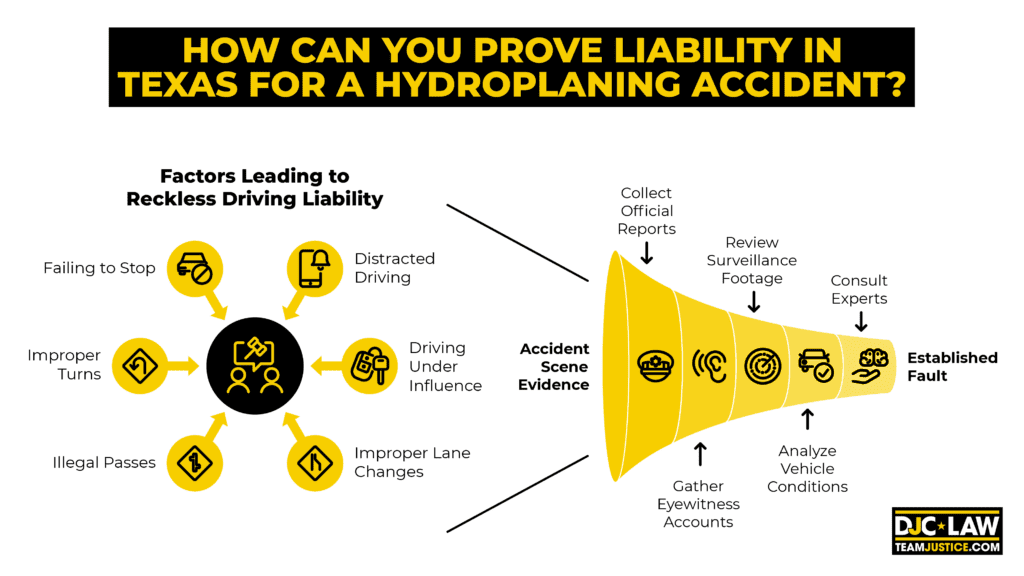
Proving liability in a hydroplaning accident relies on gathering appropriate evidence to find fault with the other driver. In most cases, if a driver is hydroplaning, responsibility will fall on them. However, it’s still necessary to prove that the at-fault driver failed to take the appropriate precautions to prevent hydroplaning.
In the beginning, liability focuses on whether the other driver was following the rules of the road. Examples of reckless or negligent behaviors that could have led to these accident types include:
Distracted driving
Driving under the influence of drugs or alcohol
Improper lane changes
Making an illegal pass
Making an improper turn
Failing to stop when required by a stoplight or sign.
Like any other accident, proving negligence requires gathering evidence to present as part of your case. Working with an attorney is crucial for gathering the appropriate evidence. Working with a San Antonio car accident lawyer ensures you have the legal expertise needed to collect and present compelling evidence effectively. Some of the tools you can use to prove fault include:
Official police accident reports
Eyewitness testimonies
Traffic surveillance footage
Dashcam footage
Photographs from the scene
Expert witness testimony
Weather reports and road conditions
Vehicle conditions
Tire conditions
You can never have too much evidence. Remember, the other side will also try to discredit the evidence in place and present their own. Hire a personal injury lawyer to ensure you can prove liability and get the settlement you deserve.
What Financial Losses Can You Recover After a Hydroplaning Car Accident?
Texas is an at-fault state, meaning the liable party must cover all your losses, including tangible losses like medical bills and lost wages and intangible losses, such as pain and suffering. All accident victims have the right to be “made whole” again as part of a fair settlement.
Some of the financial losses you can claim include:
Medical costs
Future medical bills
Lost wages
Future lost income
Property damage
Loss of companionship
Loss of enjoyment of life
Wrongful death
Not every loss category will apply to your case. What you can claim will depend on the extent of your injuries and their impact on your life. For example, you’re likelier to have a larger settlement if you suffered injuries considered life-changing compared to if you only sustained minor cuts and bruises or broken bones.
How Does Hydroplaning Lead to Accidents?
Vehicles use their tires to maintain contact with the road, helping them to keep control through friction. Hydroplaning causes a water build-up beneath the tires. If not displaced, the car's tires lose contact with the road surface, resulting in loss of control and driver drift.
Inexperienced drivers are likely to be involved in accidents because they don’t know how to react when hydroplaning occurs. Most drivers will attempt to slam on the brakes or jerk the wheel to get the vehicle back under control.
Sudden movements lead to the brakes locking up or the vehicle spinning entirely out of control, with devastating consequences.
So, what should a driver do if they start to hydroplane?
Take your foot off the accelerator.
Turn your steering wheel into the kid to enable your tires and steering to resynchronize.
Use a light pumping action on the brakes.
Wait until the tires reconnect with the road's surface and continue driving as usual.
Everything you do when you start hydroplaning feels entirely unnatural, as if it would make the issue worse, but there’s a logic to it, and it’s prevented countless fatal road accidents over the years.
Actionable Tips to Avoid a Hydroplane Accident
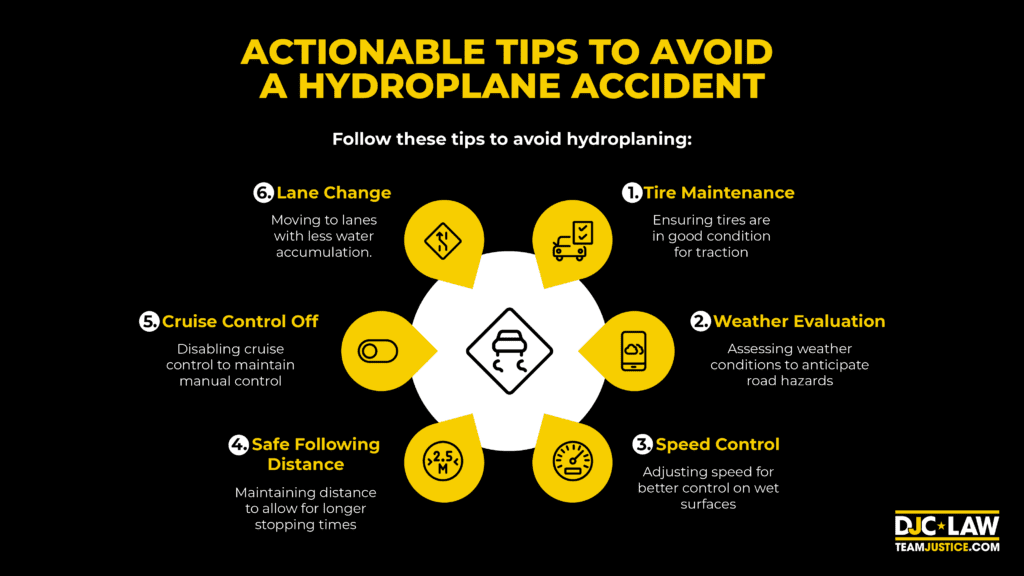
Nobody wants to end up hydroplaning, which is why there are ways to prevent it. Good vehicle maintenance and smart driving techniques will prepare your vehicle for heavy weather. Follow these tips to avoid hydroplaning.
Check Your Tires – Always check your tires before driving. Pay attention to your tire tread and that they’re inflated correctly. Have your tires rotated frequently and replace them when needed. This rule applies to all roadways, regardless of the conditions. It could just save your life.
Evaluate the Dangers – Light and heavy rain are equally capable of causing hydroplaning. Check the weather conditions and be aware of when roads are reaching potentially dangerous conditions. Many hydroplane accidents are caused by drivers being surprised.
Drive Slower – Slowing down is the most impactful move for wet roadways. You’ll have better visibility, and your tires will have more natural traction against the road. The correct speed depends entirely on the amount of rain, your tires, and the type of roadway. Experts are divided on this issue, but most say 30-45 mph is a safe driving speed.
Hang Back – Leave more space between you and the vehicle directly in front of you. In wet conditions, your braking distance increases substantially, meaning if something happens to you or the person in front, you’re likelier to hit them. For example, braking at 35 mph on dry pavement enables you to stop at 60 feet. In wet conditions, this increases to 120 feet.
Turn Off Cruise Control – Driving with cruise control makes your tires spin faster if you begin hydroplaning. Turn off this feature to avoid a relatively minor hydroplaning incident becoming a disaster.
Change Lanes – Right lanes tend to have more standing water because of their deeper depressions. Likewise, outside lanes with curbs tend to funnel extra water flow. Try to change lanes so that your tires have to contend with less water.
Ideally, avoid driving if a storm is approaching unless you absolutely have to. The best way to avoid hydroplaning is to avoid driving when there’s a high risk of losing control of your vehicle.
Steps to Take After a Hydroplaning Car Accident
When you’re involved in a hydroplaning auto accident, stay calm and composed. Your priority is to get to safety and to prioritize your health. All accidents are traumatizing, and your body is full of adrenaline. What you do in those initial few moments will impact any future claim you make.
Follow these steps after your accident:
Step One – Check yourself and any passengers for signs of serious injuries. If you require medical attention, call 911 and ask for an ambulance to attend.
Step Two – Call law enforcement and ask for a police officer to attend. Under Texas law, you must ask the police to attend if there are any injuries or the potential for more than $1,000 in property damage. Plus, an official police accident report is critical evidence after an accident.
Step Three – Exchange insurance details with the other driver. If drivers fail to do so, it's considered a hit-and-run offense.
Step Four – Gather evidence from the accident scene using your phone. Take pictures of any damage to your vehicle and any visible injuries. You should also seek out eyewitnesses and ask for their contact details. Beware that eyewitnesses aren’t required to cooperate, so respect their decision if they refuse to give a statement.
Step Five – Seek medical attention even if you feel fine. Some auto accident injuries may take hours to show themselves once the adrenaline has worn off. Examples of common delayed injuries include traumatic brain injuries like concussion.
Step Six – Notify your insurance company of the accident. Most policies require you to report any accident within 24-72 hours. Failing to do so could invalidate your coverage, meaning you’ll be left unprotected.
Once you’ve dealt with the formalities of reporting your crash and seeking medical attention, contact a car accident attorney in Texas for your next steps. They’ll provide personalized legal advice, inform you of your rights, and take control of your case. By contacting a car accident lawyer, you increase your odds of claiming a fair settlement.
How Can Our Car Accident Lawyers Help With Your Personal Injury Lawsuit?
Our car accident lawyers are there to fight for you. We’ll support you in proving liability and giving you the breathing space required to recover from your injuries and move on with your life. Some of the ways we support our clients include:
Identify your losses and determine how much your case could be worth.
Obtain all the physical evidence you need to build your case against the negligent driver.
Negotiate with insurance agents on your behalf.
Represent you in all meetings to ensure you are not taken advantage of.
File your insurance claim or personal injury lawsuit.
Advocate for you if your case goes to a formal court trial.
Contacting a lawyer is the best way to maximize your final settlement and ensure you’re properly compensated for your losses. If you’ve been in a hydroplaning accident, get in touch today.
Hydroplaning Accidents FAQs
How long do you have to file your hydroplaning accident claim?
Texas law gives you two years to file your claim under its statute of limitations. If you don’t file your case in time, you lose your right to claim. Find out how long to claim injury after a car accident in Texas to ensure you act within the legal timeframe.
What cars hydroplane the most?
All-wheel drive vehicles are especially prone to hydroplaning because of the computers inside them. When hydroplaning, they’re likelier to shift power to the rear tires, which makes the situation worse. Larger vehicles are the least likely to hydroplane because their weight provides superior grip.
At which speed are you most likely to hydroplane?
Vehicles are statistically likeliest to hydroplane at 35 mph. Limiting your speed while driving is essential, but you don’t want to go too slowly, either. Most experts recommend using the road’s speed limit as your guide and driving five to ten mph below it.

